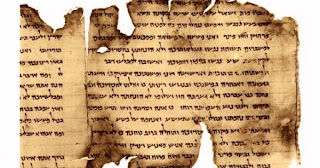The Dead Sea Scrolls - Session Three
The Hodayot (Thanksgiving Hymns)
Hartmut Stegemann, one of the modern editors of the text of the Thanksgiving Hymns comments, “This collection of hymns is usually called the Hodayot, ‘Songs of Praise,’ since many of the hymns begin with ‘odekah ‘adonai, ‘I praise you, O Lord.’” Stegemann notes that “Actually, this lengthy manuscript is composed of a number of smaller hymn-collections, which also existed individually.” (Stegemann, The Library of Qumran, 107)
Our most significant manuscript is a lengthy manuscript from Cave 1. The beginning and ending of the scroll are damaged, but some of that can be pieced together from fragments of other copies found in Cave 4. The Cave 1 scroll appears to have contained twenty-eight columns and thirty-five hymns.
The question of authorship is contested, but Stegemann claims that “the seventeen hymns of the middle part of the manuscript – columns 1-11 in the editors’ numbering – were composed by and large by the Teacher of Righteousness himself. They reflect his personal destiny, his claim to be the only legitimate high priest one day in the future, and they praise God for his goodness and fidelity in all that occurs.” (Stegemann, 107)
Vermes and others are more reserved on the question of the Teacher’s authorship. Certainly, another member of the community might have written later in the “Teacher’s voice”. However, James VanderKam offers evidence that seems compelling: “The reference to God’s ‘Law engraved’ on the poet’s heart, the fact that his opponents traffic in ‘smooth things,’ and association of their festivals with ‘folly’ are interesting points for understanding the nature of the speaker, his group, and his opponents. Later, the poet sings about how God has hidden his law within him and of how the men of the covenant, those who follow God’s ways, inquire of him and listen to him. Nevertheless, the mystery concealed in him led to problems even with his friends.” (VanderKam, The Dead Sea Scrolls Today, 86-7) He suggests that at least some of the hymns represent a sort of “autobiographical poetry.” What is certain, though, is that these are surely sectarian texts that give us insight into the struggles of the community. Vermes suggests that the so-called Teacher Hymns consist of 1,2, & 7-11 in his numbering.
The reconstruction of the text is complicated, since the original publication of the Cave 1 text by Sukenik, fragments from Cave 4 have made scholars (Stegemann, Schuller, & Puech) examine how these hymns might have circulated and they now postulate a series of hymn collections. This has led to the reordering of the material since it was originally published. Vermes attempts to offer us the text according to these reconstructions while retaining references to Sukenik’s ordering, and thus, there is some confusing column numbering in his text.
In general, Vermes notes that “the poems contained in the Scroll are similar to the biblical Psalms. They are mostly hymns of thanksgiving, individual prayers as opposed to those intended for communal worship, expressing a rich variety of spiritual and doctrinal detail.” He further notes that “the two fundamental themes running through the whole collection are those of salvation and knowledge.” (Vermes, Complete Dead Sea Scrolls, 249) However, it is also suggested that the non-teacher hymns may have been used communally in rites of entry into the Community.
The Thanksgiving Hymns are heavily dependent on the Biblical psalms, the cadences of which can be noted throughout.
For reflection:
1. To what degree, in your reading, can you distinguish between hymns of the Teacher and hymns of the Community?
2. Try to see if you can spot allusions or citations from Scripture in the Hymns (especially from the Psalter).
3. What do these hymns add to our knowledge of the Community?




Comments